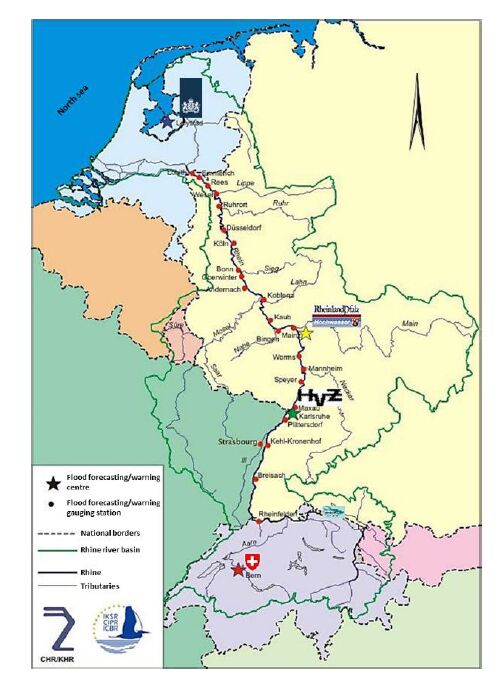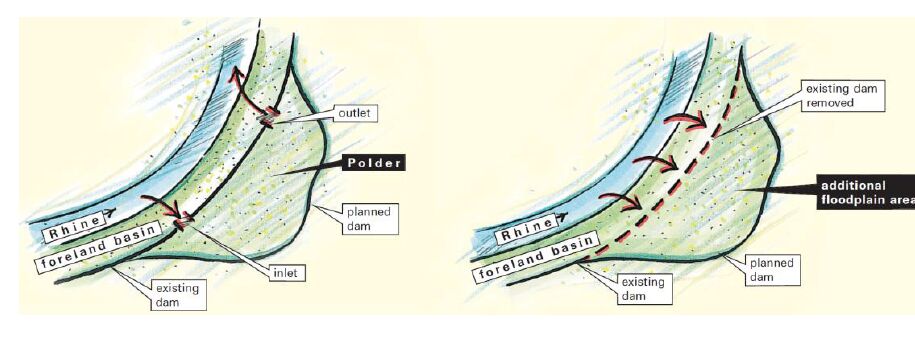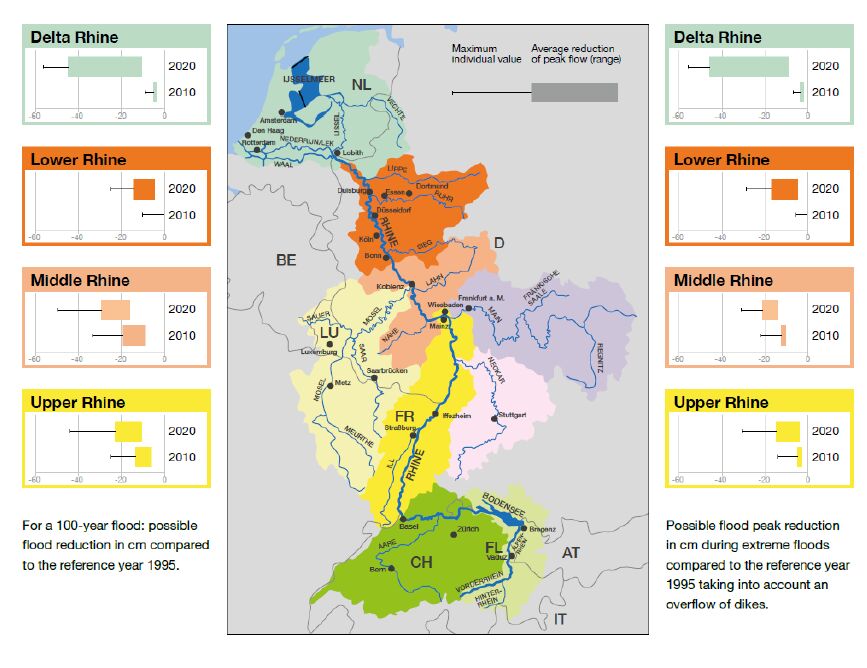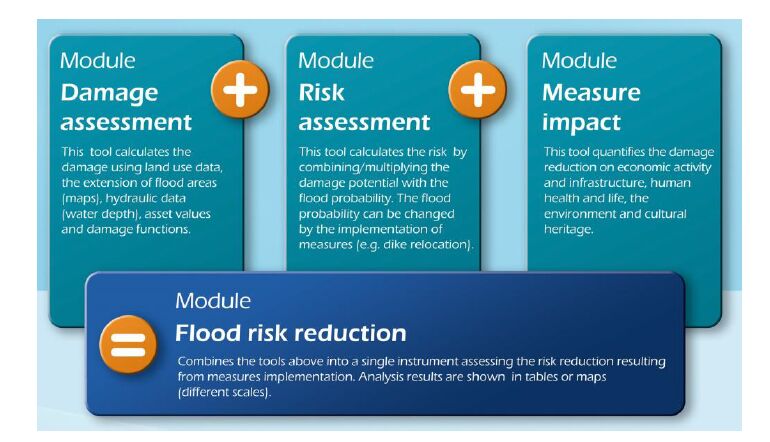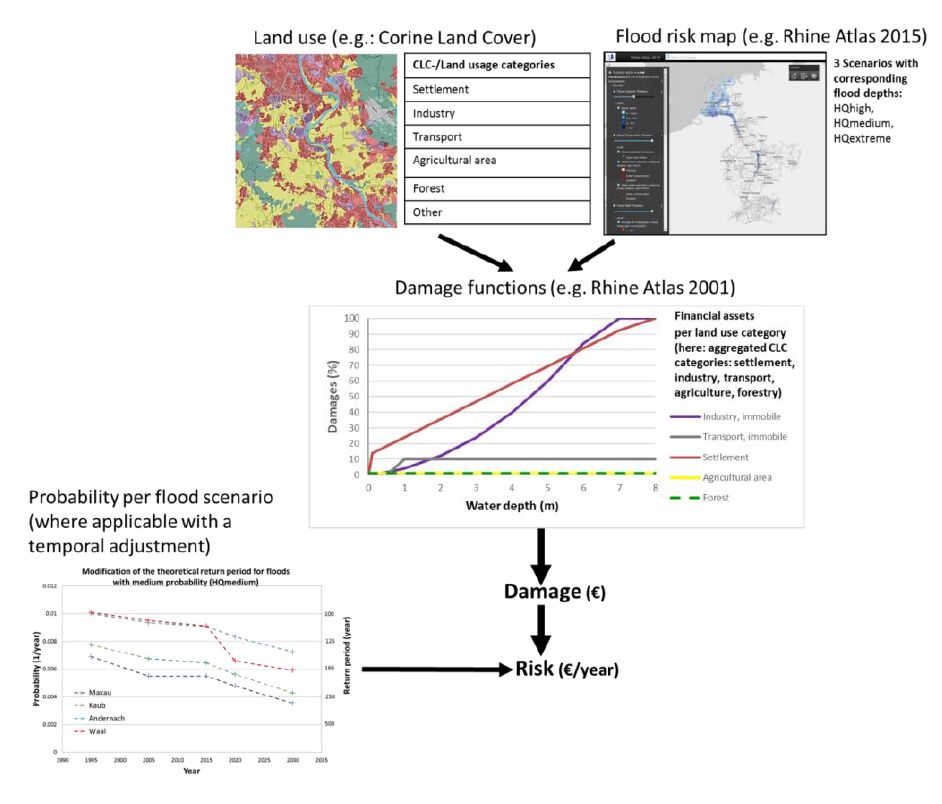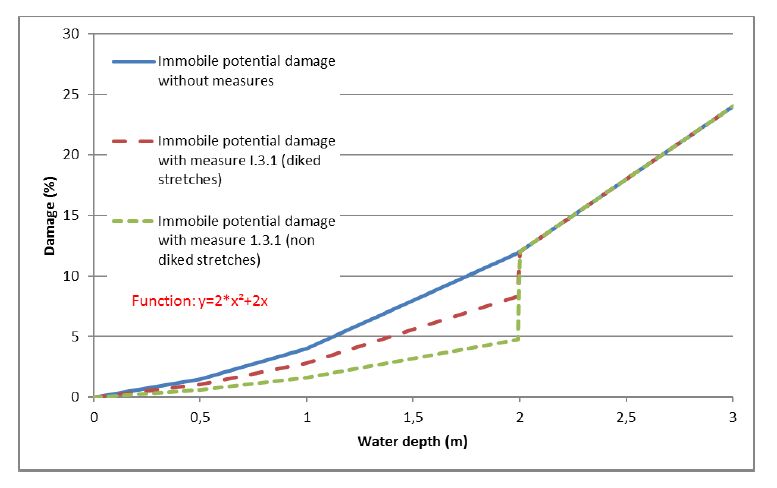1. Introduction
The Rhine connects the Alps to the North Sea. It is 1232 km long and one of the most important rivers in Europe. The river catchment area covers some 200,000 km2 and spreads over nine countries: Italy, Austria, Liechtenstein, Switzerland, France, Germany, Luxemburg, Belgium and the Netherlands. Approximatively 60 million inhabitants live within the Rhine basin. The topography of the Rhine catchment is various, from high, middle and low mountain chains to lowlands and low-lying valleys, and includes different climatic zones (alpine, low mountainous, atlantic, semi-continental climate). Different discharge regimes are overlapping (nival regime in the South, pluvial regime in the Central Upland region—is composed of the sub-basins of Neckar, Main, Nahe, Lahn, Moselle, etc.—and combined regime in the North), resulting in an increasingly uniform yearly discharge distribution in time and flooding. Furthermore, the impact of climate change on the water regime of the Rhine and more specifically the discharge leads to more homogenous runoff in the south, while the seasonal distribution becomes more marked in the north [1]. Indeed, according to study undertaken in the Rhine basin [1] climate change could lead to increased precipitations, mean discharges as well as mean flood runoffs in the winter and a decrease of these parameters in the summer. Together with land settlement and man-made water works, these natural conditions have resulted in diverse flood patterns and catastrophes in the past.
Under the umbrella of the ICPR, 8 countries and the European union (EU) closely cooperate through their representatives and delegates in water and flood risk management since 1950. The Convention on the Protection of the Rhine [2]—replacing the Treaty of Bern signed in 1963 [3]—is the basis for international cooperation for the protection of the Rhine within the ICPR. Representatives of the governments of the Rhine countries signed the Convention on 12 April 1999. They thus formally confirmed to continue to protect the valuable character of the Rhine, its banks and floodplains by increased cooperation. The convention is being completed by the Financial regulations and rules of procedure of the ICPR [4]. Furthermore, international cooperation draws upon various European directives and regulations requiring coordinated implementation in the entire watershed, such as the European Water Framework Directive (WFD) [5] the European Flood Management Directive (FD) [6]. For the purpose of these directives, the official unit of management of the Rhine basin is called the "International river basin district of the Rhine" (IRBD).
Two catastrophic flood events, which occurred in 1993 and in 1995 due to extremely high discharges in particular from the Moselle catchment and of the Rhine downstream of Koblenz, caused much damage on the Lower Rhine (1993: 1.4 billion € and 1995: 2.6 billion €). 1995 has seen the evacuation of 250,000 people (Rhine delta) due to potential dike failures. As a result of these flood events, the ICPR has implemented the Action Plan on Floods (APF) since 1998, which includes specific action targets to be implemented by all parties [7]. Since 2007, the ICPR was mandated by the Ministers of the Rhine to be the coordinating body of the national implementation of the WFD and FD within the unit of management of the IRBD Rhine. Consequently, the ICPR has established a framework for the exchange of information and coordinated implementation of the FD. According to the FD, different common products (reports, maps) have been completed and published, particularly the first overall Flood Risk Management Plan (FRMP) for the Rhine basin [8] issued in December 2015, which lasts from 2016 to 2021, is the follow-up plan of the above mentioned APF. Furthermore, the ICPR published the first Climate Change Adaptation Strategy for the Rhine catchment in early 2015 based on solid climate change effects studies [1,9].
2. General information
2.1. Overview
Within the ICPR, the exchange of information on cross-border flood risk management is based on concrete work resulting from the international cooperation of the nine parties mentioned above in the Rhine catchment and especially embodied by the working group on floods and its expert groups.
In concrete terms, the delegates nominated by each contracting party execute the cooperation on flood management and the coordination of the implementation of the FD at an international level. Delegates are mostly coming from water management sectors (environmental or foreign affairs ministries and administrations). Working and expert groups related to the topic of flooding, with permanent or fixed-term mandates, deal with technical questions that they pass on to the Strategy Group preparing the Plenary Assembly, where main decisions are taken. Expert groups on flood risk analysis, hydrological and/or hydraulic model calculation (e.g., of the effects of retention areas) support the working group "Flood". Since 1999, different interest groups and NGOs in different fields represent the public in meetings with the working group "Flood": flood protection of riparian municipalities, environmental conservation and ecological restoration of flood plains as well as cultural development of the Rhine. While not authorized to make decisions, these observers can raise criticisms and provide their opinions, which are taken into account by the countries. The working and expert groups are supported by the international staff of the secretariat of the ICPR secretariat in Koblenz. The secretariat prepares the contents of all meetings, oversees their organization and provides linguistic support in the working languages German, French and Dutch. The secretariat is obliged to be impartial.
This structure involving different levels of decision taking (from the top with ministers to the bottom with national/regional administrations and stakeholders) allows for pertinent exchanges, discussions and negotiations which—along with the time factor—are the key for resolving potential and real conflicts arising from the diverse uses of the Rhine.
2.2. Coordinated implementation of the Floods Directive within the international Rhine basin
The extensive cooperation and coordination in the field of flood management on the level of international river basin districts is stipulated by the FD whose objectives are the reduction of potential adverse consequences of floods for human health (physical and psychosocial impacts, casualties), the environment, cultural heritage and economic activities through an overall flood risk management (measures for prevention, protection and preparedness).
Based on the principle of solidarity and for measures potentially increasing transboundary flood risks, the countries involved in the Rhine Commission should coordinate work to come up with a common solution for the measures in question. Therefore, the ICPR was given the mandate [10] to carry out the coordination and exchange of information indicated in the FD for the IRBD Rhine which refers to the network of water bodies at level A (= sub-catchment areas > 2500 km2).
As a non-EU member, Switzerland is not obliged to implement the FD but based on national law, it supports the coordination of the EU Member States with respect to implementing the FD. The same is true of Liechtenstein, the FD being not yet transposed into law in the European Economic Area (EEA).
After a successfully "preliminary flood risk assessment" [11] and drafting "maps of flood hazard and flood risk" [12] as required by the FD, the countries and regions/Länder (German federal states) with a share in the IRBD Rhine coordinated work, and based on the 1998 APF and the principle of subsidiarity, they drafted the first FRMP composed of:
- A subordinate management plan for the network of water bodies (level A): It emphasizes measures with transboundary effects and measures which the countries estimate to be relevant for the entire river basin;
- And national and/or regional management plans as well as such coordinated at the level of international sub-basins (level B).
The first FRMP of the IRBD Rhine, which is further detailed in sections 3.1 and 3.2 is thus an overall plan for the whole Rhine catchment with common agreed principles, targets and measures to be realized and implemented on an international or national level. The EU Member States contracting to the ICPR use this international plan for their reporting to the EU in the frame of the FD and hence prove the coordination and exchange of information on the international basin of the Rhine. Along with this, the EU Member States have their own national and regional FRMPs for sub-catchments of the Rhine.
2.3. Instrument for the assessment of the impact of flood risk measures on risk evolution
To carry out regular reviews of the impacts of measures on flood risk reduction for the new FRMP of the IRBD Rhine, the ICPR has developed a method that was integrated into a geographical information system (GIS). This GIS-tool (see section 3.3) can also be of interest to other river basin commissions. Upon request, the ICPR provides the tool and the methods to other countries, respectively their authorities or scientific organisations.
3. Outcomes
3.1. A flood risk management plan for the transboundary Rhine basin
3.1.1. Principles of the FRMP
As required by the FD for transboundary basins, the Countries of the Rhine have set principles for the overall FRMP permitting the avoidance of conflicts of interests between the countries or different uses (navigation, hydropower, development of cities, …) [8]:
1. Flood risk management in the international Rhine river basin rests on the basic values of responsibility, solidarity and proportionality as well as on synergy with other EU policies (WFD, Natura 2000, etc.).
2. Flood risk management is holistic and sustainable; the level of security to be achieved must be ecologically acceptable, economically reasonable and socially bearable.
3. Flood risk management is a community task. Therefore, all those implied and concerned must develop, solidify and maintain risk awareness.
4. Such tasks can only be carried out jointly with a distinct distribution of tasks between all decisional levels (local, regional, national, international). Cooperation with the population is particularly important at a local level.
5. Even an optimal combination of measures within flood risk management does not grant absolute security when handling nature events (such as extreme floods): There is no full security; there will always be a residual risk which should be considered.
An example of conflict which shows obstacles to these principles arising between flood risk protection, local population and land owners as well as with the ecological sector on the Upper Rhine is the construction of retention basins and the relocations of dikes. On the one hand, more space for the river is needed to reduce water levels and assure an acceptable safety level for the cities downstream of the impounded Rhine. On the other hand, there is an obstacle of sociological acceptance from sides of the users and the population which can be reluctant when it comes to creation of such retention measures "in their backyards" (fear of increased flood hazard through groundwater flooding, fear of decreased property value, …). This shows the limits of the so-called upstream-downstream solidarity and thus the realization of such measures is only possible when combined with sound analysis of diverse consequences for various users and compensatory measures. The latter can be very time consuming (slowing of the execution).
3.1.2. Targets of the FRMP
Considering the provisions of the FD stipulating that the flood risk management plans comprise all aspects of flood risk management but focussing on prevention, protection and preparedness, the countries in the Rhine catchment have agreed upon the following overriding, general targets (Figure 1).
Relying on these targets, the countries have decided joint measures presented in next section.
3.2. Joint flood risk management measures of the FRMP
The FRMP for the Rhine basin describes measures with cross-border effects and measures, for which an international coordination and—in any case—an exchange of information between the countries in the Rhine catchment are important. The national, regional or local reports on the Flood risk management plans include surveys of all national measures and all details on national flood risk management.
3.2.1. Improved exchange of information and access to information
The mutual exchange of information on flood risk management is done at ICPR level. In order to increase risk awareness and thus reduce potential adverse consequences, the population is being informed about flood hazard on a national, regional or local scale, so that regional specifics may be considered. Besides, awareness is supported by supra-regional measures at ICPR level, such as the digital "Rhine Atlas 2015 (flood hazard and risk maps of the IRBD ‘Rhine’)" [13].
This communication means is made by harmonized national flood hazard and flood risk maps for the main Rhine river, and localizes the kind and degree of danger for three flood scenarios (high: 10 years returning period, medium: approximately 100 years returning period and low flood probability: extreme scenarios, e.g., 1000 years returning period) from the Alpine Rhine to the North Sea. Further, background and detailed information (e.g., links to national maps, number of people affected, volume of retention measures…) is available by clicking on any area of the atlas.
3.2.2. Improve flood forecasting and warning systems
Flood forecasting and flood announcement helps to reduce damages in case of a flood event through better preparation. Therefore, the countries, Länder and regions in the IRBD Rhine cooperate at an international level when exchanging data on discharge and precipitation for use in flood forecasting.
Along the main stream of the Rhine, the flood centres in Switzerland and in the German Länder Baden-Württemberg, Rhineland-Palatinate (together with the federal Water and Navigation Administration), France and the Netherlands are in charge of this task (Figure 2).
Since their introduction, existing flood announcement systems have largely contributed to damage reduction by improving the preparedness of people (e.g., improved evacuation, implementation of individual prevention measures), businesses and crisis management actors. This was confirmed by the calculations that were done with the tool presented in section 3.3.
In fact, according to the last assessment of the APF, the hydrological forecasting systems used by the flood warning centres on the Rhine have been considerably improved (forecast periods are prolonged from 24 to 48 hours on the Upper and Middle Rhine and from 48 to 96 hours on the lower Rhine) and refined during the past years [7].
3.2.3. Implementation of measures aimed at lowering the water levels
The 15th Conference of Rhine Ministers in 2013 stated that, due to the effects of climate change and the expected increase of the number of flood events and also considering the possibility of a greater probability of extreme events, flood risk management measures, such as keeping flood-prone areas free from further uses or creating more flood retention areas/more room for the river will become increasingly important. In this regard, continuing implementation of all measures aimed at lowering water levels or of retention measures in the countries of the Rhine catchment has been planned until 2020 within the frame of the APF, which has been included in the FRMP of the IRBD Rhine. Furthermore, the coordination or synergies between the FD and the WFD [5,14] has been underlined in the FRMP when implementing and realizing retention and renaturation measures.
For above mentioned measures and other measures regulating discharges, the construction or strengthening of dikes, etc, the ICPR has stated in the FRMP the application of a special approach to avoid conflict and obtain the best transnational effects:
1. Regional or local measures which are known not to have any transboundary effects will be planned and implemented regionally/locally;
2. For regional measures with transboundary effects, there will at first be an exchange of information at a bilateral level or within river basin commissions for sub-basins, for example the Moselle-Sarre. Eventually, these measures must be coordinated on a bilateral or trilateral level to find joint solutions;
3. The measures with regional effects mentioned under (2) might also cause supra-regional effects. Therefore, such measures must be included in the mutual exchange of information within the ICPR. Using this approach, measures with transboundary effects are coordinated throughout the river basin district. The effect of planned measures must be determined in common (see GIS-tool in section 3.3). Aspects of cost-effectiveness may be taken into account;
4. National or regional agreements targeting to keep floodplains free of all uses should be enhanced (see below); There should be an exchange on these activities within the ICPR.
The following measures are to be coordinated between the countries and must be realized in order to re-establish the formal retention effect of lost flood plains: measures aimed at lowering the water level (Figure 3) e.g., future retention areas, dike relocation, measures from the Dutch program "Room for the river", renaturing, and keeping discharge corridors free (see list of measures in Table 1). Further measures for securing of the surfaces under aspects of spatial planning are also being determined in the FRMP.
The following table shows the localization and available retention volumes of water level reduction measures along the Rhine in 1977, 1995 (reference year for the APF), 2005 and 2014 considering the measures accomplished in each of the years. Indications for 2020 and 2020+ (approximately 2030) correspond to the state after the realization of all measures planned (Table 1) [8].
Table 1. Retention measures between Basel (CH) and Lobith (NL) and corresponding volumes (in million m3).
Recently, the ICPR examined the effects of these constructed and planned retention measures on the reduction of water levels. Based on this examination, a reduction of flood peaks will be achieved once all foreseen measures have been implemented (Figure 4) [15]. The results permit a substantiated evaluation of the effectiveness of measures implemented and of their contribution to achieving the objectives of the FRMP.
Figure 5 shows average changes of water levels of the Rhine in 2010 and 2020 for the different sections of the Rhine for different synthetic flood waves with a returning period of 100-year and extreme floods (e.g., returning period of 1000-year). For the Rhine Delta, possible average water level reductions for extreme floods in 2020 reaches from 9 to 46 cm (with maximum individual values of 56 cm) compared to 1995 where only a few water stage lowering measures were in place (Table 1). The calculation conducted for water level decrease due to retention in case of extreme floods is considering an overflow of dikes, using hydraulic/hydrodynamic models to simulate dike failures on the Upper Rhine [7,8,15].
The reduction of water levels by different corresponding measures along the Rhine (Table 1) may also lead to reduced flood probability [16]. As an instance, we can take the Waal, one branch of the Delta Rhine where a flood of low probability (16,000 m3/s at the gauging station of Lobith - NL) is associated to a theoretical returning period of 1050 years in 1995. The realization of all retention measures leads to a returning period of 2178 years. In other words, flooding becomes less frequent. This equally results in a reduction of flood risks. The results of this specific study done by the ICPR [16] were used for calculating the modification of flood risk with the GIS tool (see section 3.3 below).
3.3. Instrument for the assessment of the impact of flood risk measures on risk evolution
3.3.1. General information
The ICPR, supported by the engineering consultant HKV, developed a quantitative method and an instrument (or tool) aimed at determining past, present and future flood risks considering the impact of different measures (Figure 5) [17,18]. The method has been implemented as a new GIS-tool entitled "ICPR FloRiAn" (Flood Risk Analysis) in the form of a toolbox in ArcGIS Spatial Analyst. The tool consists of three interacting calculation modules (Model Builders) resulting in an overall damage risk evolution/reduction assessment (Figure 5).
The ICPR operates this tool using its own input data to assess risk reduction and evolution on the Rhine from 1995 up until now [17] as well as to carry out regular reviews of the impacts of measures on flood risk reduction for the FRMP Rhine (see results of calculation in section 3.3.3). The tool works in a consistent, reproducible and transparent manner, is available on demand at the ICPR and is applicable to/can be used by other river basins.
3.3.2. Background method and computing process
Flood hazard and flood risk maps (e.g., developed under the FD and harmonized within the ICPR in the form of the Rhine atlas 2015) are the basis for the tool. The calculations of the flood risk are carried out using a GIS. In the tool, the calculations take place at the level of raster cells. During the evaluation, the results of individual raster cells are aggregated at the desired level in table: e.g., stretches of the Rhine, municipality, region, and country. In the following, the calculations are described at raster cell level in terms of individual events/time horizons. A calculation can subsequently be undertaken comparing different years, in order to evaluate the change or reduction in the risk due to theoretical or actual measures implemented.
The method underpinning the tool is based on the definition of flood risk being the product of the potential damage and the flood probability. The overall procedure of the method and the calculation is shown in Figure 6.
In accordance with the FD for potential adverse consequences/damages, a distinction is made between human health, the environment, cultural heritage and economic activity (= risk receptors). In terms of all four receptors, the focus lies upon the direct consequences of flooding (no estimations of consequential losses e.g., due to interruptions to production). The flood risk for the four receptors, based on national data taken from the flood risk maps, is being determined within the method/tool in four different ways:
1. In terms of human health, the number of people affected in the event of a flood is used as a parameter. Further, the number of people who cannot get to safety or be evacuated are established using area-specific "safeguarding rates".
2. In terms of environment and cultural heritage, a different approach is taken, whereby a classification based on the combination of water depth categories and categories relating to the vulnerability of potentially affected protection areas as well as the significance of cultural heritage. It provides a matrix, through which the potential damage can be assessed.
3. In determining the risk with regard to economic activity, land use maps (e.g., Corine Land Cover (CLC)) are used together with flood hazard maps (assumption made: same flood hazard for all time horizons, no changes of water depth, velocity or extension in time due to measures). A monetary risk is determined based on the flood level corresponding with a certain flood probability/return period and existing economical/asset value (the latter can change in time) through depth-damage functions (for the different land use categories). (Figure 7).
In addition, theoretical, planned or implemented measures according to the categorisation of the FD are integrated in the tool (Table 2) [19]. They can be divided into ones having an impact on flood probability (protection measures see section 3.2.3) and those which have an impact on the potential adverse consequences/damage (measure of the categories "prevention" and "preparedness"). In order to calculate the effectiveness of measures, indicators were defined for each measure category (Table 2). On the basis of literature and expert knowledge, the maximum reduction in damage per indicator was estimated and defined (= the effect). The degree of realisation (= numbers, localisation and date of implementation of measures) was integrated into the calculations. The indicator is therefore the combination of the effect and the degree of realisation which both can be set/determined individually by the users (flexibility) [18].
Table 2. Overview of the measures and indicators integrated into the instrument and the calculations.
| Type of measure |
Indicator
|
| Prevention |
|
| Spatial planning, regional planning and land use planning |
Building regulations and codes/building development plans, in which requirements for flood protection are contained (flood-adapted construction)
|
| Keeping flood prone areas open/clear (preventing the location of new or additional receptors) and adapted usage of areas |
Modification of land use data (CLC data) within and outside of the flooding areas of the FHM under analysis.
|
| Flood-adapted design, construction, renovation |
Measures implemented regarding flood-adapted development/building
|
| Precautionary building/flood-proofing property for households/municipalities |
Protected areas due to precautionary building/flood-proofing property and/or mobile systems
|
| Precautionary building/flood-proofing property in hazardous installations (IPPC plants, SEVESO operation areas and waste water treatment plants) |
Protected installations due to technical protection, precautionary building/flood-proofing property and/or mobile systems
|
| Flood-proof storage of water-polluting/hazardous substances for households/municipalities |
Securing oil tanks and/or safe storage in upper storeys
|
| Flood-proof storage of water-polluting/hazardous substances for hazardous installations (IPPC plants, SEVESO operation areas and waste water treatment plants) |
Securing oil tanks and/or safe storage in upper storeys
|
| Provision of flood hazard and risk maps/establishing awareness in relation to precautionary behaviour, education and preparation/preparedness for flood events |
Frequency/update intervals with regard to information campaigns (incl. provision/presence of flood hazard and risk maps)
|
| Protection |
|
| Retention measures |
Modification of probability (ICPR Report No. 229)
|
| Dykes, dams, flood walls, mobile flood protection, ... |
For these measures, a probability is also indicated: Percentage evolution/change in flood probability between 1995 and present day due to improvements in protectionThe information whether the area is protected/diked or non-protected/non-diked is relevant for the calculations
|
| Maintenance/renewal of technical flood protection structures
|
| Preparedness |
|
| Flood information and forecast |
Improvement in flood forecasting within defined time-period
|
| Alarm and emergency response planning (incl. recovery/aftercare) /warnings for those affected/exercises/training |
Presence and update frequency of alarm and emergency response plans; number of warning systems (warning methods/ways and communication means), details of civil protection/crisis management exercises including frequency
|
| Safety/safeguarding/evacuation of (potentially) affected persons |
Details of minimum and maximum safeguarding rate for those affected in a particular area
|
Depending on the receptor, the type of measure/indicator, the impacts of measures is computed in different ways in the method/tool [18]:
- Main way: modification of damage curves due to measures (receptors affected: economic activity, cultural heritage and environment for some measures related to the protection of potential polluting installations) (Figure 8)
- Changes of impact range of polluting installations (environment)
- Changes in amount of people evacuated/put into safety as a result of combination of non-structural measures
- Various measures present different effects whether the area is protected/diked or non-protected/non-diked. For example, for "Precautionary building" like flood-adapted construction and flood-proofing property it is assumed, because the people affected in non-diked areas have more experience of flooding (flooding occurs here more frequently than in diked areas) the reduction effect in terms of potential mobile damage (household items) is higher (Figure 8).
3.3.3. Results of calculation with the tool
The assessment and calculations ran by the ICPR to demonstrate the evolution of the flood risk on the main stream of the Rhine and possible reduction during the period 1995-2030 [17] have revealed the following:
1. When considering the risks to human health, it is apparent that safety/evacuation from flooding plays a particularly important role. Measures such as safeguarding/evacuation of those potentially affected, raising awareness, flood forecasting and warning and alarm plans as well as the modification of the probability of flooding all help to mitigate the flood risk. Where all of these measures are implemented, and across the three flood scenarios, a reduction in the risk for human health of approximatively 70% to 80% (1995-2020) is determined.
2. When assessing cultural heritage and the environment, based on the results of new, experimental—not proven—methods, it is ascertained that over time, damage to cultural heritage and the environment is reduced across all damage categories defined according to importance and vulnerability, and in all scenarios, due to the measures undertaken (same as economic activity but also specific measures helping to mitigate damages of potential pollutant installations). The same applies to the risk of flooding with regard to cultural heritage and the environment. Across all flood scenarios, a reduction in damage and risk of approximatively 40% to 70% for cultural heritage and the environment is obtained for the period for the period 1995-2020.
3. In terms of the economy, it has been determined that the reduction by 25% before 2020 (target stated in the APF) in contrast to 1995 can be achieved. Under a supra-regional aspect, this means: In particular, measures enabling water retention in the direct vicinity of the river Rhine, e.g., the construction of flood retention areas, the relocation of dikes and measures giving more room to the river prove—because of their possible modification of the flood probability—to be most efficient (see list of measures in Table 1). Additionally, various other measures in terms of prevention and preparedness, including flood forecasts, early warning systems and (the preparation of) crisis management, have contributed to the weakening of damage growth in flooding areas since 1995.
4. Conclusions
The experience and lessons learned by the ICPR with the APF since 1995 have led to the design of an international plan with concrete measures. The effectiveness of so-called water level lowering measures planned to be realized by 2030 have been determined, and amongst others in view of possible consequences of climate changes, the relevance of further retention measures is to be considered. Furthermore, the ICPR will use its new GIS-tool to carry out regular reviews of the Flood risk management plans for the Rhine basin by assessing the impact of measures included in these plans (amongst others water level lowering and retention). The tool was made to be applicable to other river basins and is available on demand at the ICPR.
Finally, this article provides an insight into the relevant role of the ICPR in coordinating flood risk management between all countries and other stakeholders within the Rhine basin. Through working and strategic groups, the Rhine commission is a platform for exchange between the member countries of the ICPR on national rules and measures, resulting in the setting of actions with positive transnational effects in overall plans. These measures, actions and plans are nationally implemented, thereby respecting principles like solidarity, cost sharing and responsibility.
Acknowledgements
Hereby the author would like to thank all the countries of the Rhine basin for their long-lasting fruitful contribution resulting in common and concrete results as well as for the providing the information and data required for this article. Furthermore, the author would like to show his gratitude to Anne Schulte-Wülwer-Leidig who provided expertise that assisted the writing of the paper as well as Karin Wehner and Charlie Breslin for proofreading of the manuscript.
Conflict of Interest
The author declares no conflicts of interest in this paper.









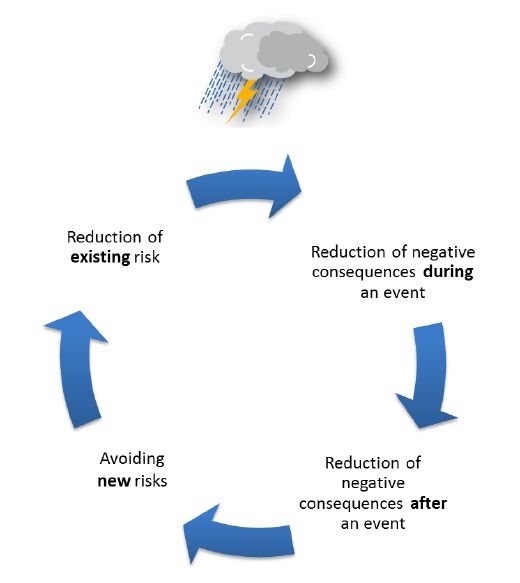
 DownLoad:
DownLoad: 